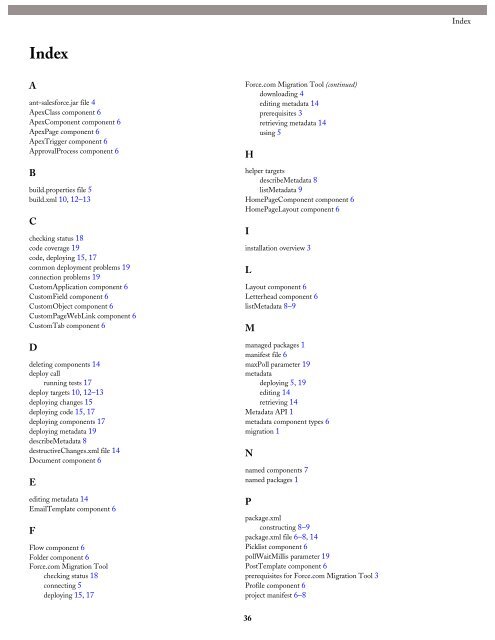
But I dont think this is recommended since the Java code, SQL code, Tiles etc are in different places and in pom.xml, only the java and resources location can be specified. If I make a separate folder for them, how do I include that in the pom.xml file?Īnother option I just thought of - would be to stuck to the existing directory structure of the project, and just make changes in pom.xml. What I am confused about is - where do I put the Tiles, JSPs, Javascript, CSS, and SQL files? Src\main\resources - which contains property files Migration Tool (ANT) Guide Here is the simple guide to setup the Migration tool (ANT). Use the extension and let me know in case of any issue or enhancement. Src\main\java - which contains the Java sourcecode We know that through ANT migration tool we can easily deploy set of components to different sandboxes hence this extension can provide you an easy way to generate package.xml.

It is recommended to run the tutorial against a mysql database, as all of the explanation in this. For this, you need to create ants build.xml file and make the necessary libraries available.

The following section outlines the necessary steps to configure a Torque-based ORM project using ant. The default directory structure of Maven is: Step 1: Configuring the Torque generation process. We arent using JUnits, so I am not concerned with test classes and test resources. The project has 3 parts - of which I have managed to migrate the first part. For the front end, have used Tiles, JSPs, Javascript, CSS. However, we are constantly improving the Data Migration Tool (see the Changelog for more details) so the migration efforts are continuously decreasing.I am trying to migrate a project from Ant to Maven.
#Ant migration tool documentation upgrade#
Just like an upgrade between 1.x versions (for example, from v1.12 to v1.14), the level of effort to migrate from Magento 1 to Magento 2 depends upon how you have built your site and its level of customization. Documentation is available online for creating Magento 2 themes, layouts, and customizations. I am trying to migrate a project from Ant to Maven. To take advantage of these advances, developers will need to make changes to their themes and customizations. Magento 2 uses new approaches and technologies that give merchants an unmatched ability to create innovative shopping experiences and scale to new levels. More information on developing extensions for Magento 2 is available in the PHP Developer Guide.
#Ant migration tool documentation code#
Now we are proud to present the Magento Marketplace, where you can download or purchase the latest versions of your favorite extensions.Īlso, we have developed the Code Migration Toolkit, which will help to port your extensions and custom code to Magento 2, significantly reducing your efforts. We have been working hard with the development community to help you use your Magento 1 extensions in Magento 2. This guide provides information on the tool and best practices for using it to migrate your data. We have developed the Magento 2 Data Migration Tool to help you efficiently move all of your products, customers, and order data, store configurations, promotions and more to Magento 2.

Magento 2 migration involves four components: data, extensions and custom code, themes, and customizations.

We are excited to share the details about this process, which we refer to as migration. Ant migration tool Anyone have any useful documentation 7 comments. We are pleased you are considering moving from the world’s #1 commerce platform - Magento 1.x - to the platform of the future, Magento 2.


 0 kommentar(er)
0 kommentar(er)
